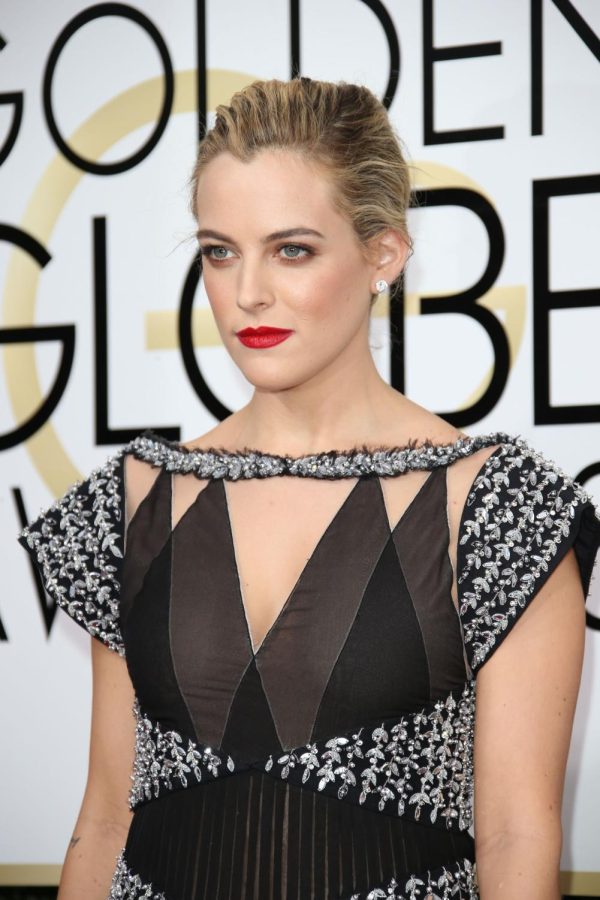Review | ‘Daisy Jones and The Six’ TV adaptation gives electric take on fictional ‘70s band, alongside album ‘Aurora’
The first three episodes of Amazon Prime Video’s newest series, ‘Daisy Jones and The Six,’ aired on March 3. An adaptation of the hit novel by Taylor Jenkins Reid, the series features a stellar cast, ‘70s music, and exciting drama.
Dan MacMedan-USA TODAY NETWORK
Jan 8, 2017; Beverly Hills, CA, USA; Riley Keough arrives for the 74th Golden Globe Awards at the Beverly Hilton.
March 7, 2023
Viewers were graced with a retro, dramatic, and musical retelling of The New York Times bestselling novel by Taylor Jenkins Reid on March 3 when Amazon Prime Video released the first three episodes of “Daisy Jones and the Six.”
I was excited for the episodes to be released. I read the “Daisy Jones and The Six” novel last year and could not wait to see all my favorite characters and songs come to life. Spoiler alert: It exceeded all my expectations.
The show and book follow the rise to fame of a rock band in the 1970s. What begins as a band called The Dunne Brothers morphs into The Six with members Billy Dunne, Karen Sirko, Graham Dunne, Warren Rhodes, and Eddie Roundtree. Despite apparent pushback from Billy, Daisy Jones eventually became the group’s lead singer.
The viewers learn from a series of interviews 20 years later that the band broke up at the pinnacle of its career, and nobody knew why. In present day, the band members agreed to share what truly went wrong all those years ago.
The show’s casting introduced lots of new talent: Riley Keough as Daisy Jones, Sam Claflin as Billy Dunne, Suki Waterhouse as Karen Sirko, Camila Morrone as Camila Dunne, Will Harrison as Graham Dunne, Sebastian Chacon as Warren Rhodes, and Josh Whitehouse as Eddie Roundtree.
Most actors looked how I pictured the book characters to be — save for Karen. In the show, she has blonde hair and a British accent, neither of which hold true in the book.
I also loved the episode format because of how it switched between present-day interviews and the energetic music performances and dramatic situations of the flashback scenes. In the first three episodes, viewers learn of the group’s rise to fame, Daisy’s past and her love for music, and bits of mystery that keep the viewer wondering what actually caused the band’s breakup.
The music is the heartbeat of the show, as it largely revolves around songwriting and band activities. We see The Six making its first album, “Aurora.” This was an exciting part of the show, as “Aurora” and all the songs on it are real lyrics from the book. “Aurora” is available to listen to as a real album on most music streaming services like Spotify and Amazon Music.
RELATED: Review | Outer Banks season 3 is a fun flop
In episode three, Billy and Daisy sing “Look At Us Now (Honeycomb).” This is the first time Billy and Daisy sing together, and I was not disappointed, as their voices harmonize well together. Both of their voices are exactly how I imagined them when reading the book.
Other infamous songs from the ‘70s are included throughout the show, like “I Feel the Earth Move” by Carole King and “Son of a Preacher Man” by Dusty Springfield. These were nice additions to the ‘70s vibe the show aims to achieve.
The episode titles similarly play with musical motifs: Episode one is titled “Track One: Come and Get It,” episode two is “Track Two: “I’ll Take It,” and episode three is “Track Three: Someone Saved My Life Tonight.” I enjoyed this added detail to the show.
I noticed a few differences between the book and the show. Those differences — like Karen’s sudden accent — didn’t necessarily take away from the story. One example is that Daisy’s name in the book is simply Daisy Jones, but the show added that her real name is actually Margaret, which makes Daisy more of a stage name.
In the book, the interviews with the band take place much further in the future — namely, in 2016. In the show, however, they are held in 1990. The difference of making the interviews 20 years into the future rather than 40 makes sense: It eliminates the need to use heavy prosthetics or makeup on the actors, as the characters wouldn’t look nearly as old in 1990 as they would have in 2016.
I believe the show was a huge success, exceeding my expectations and keeping me hooked the entire time. I will be impatiently waiting for the next three episodes to drop this Friday. Until then, listening to “Aurora” will satisfy my ‘70s rock band needs.














